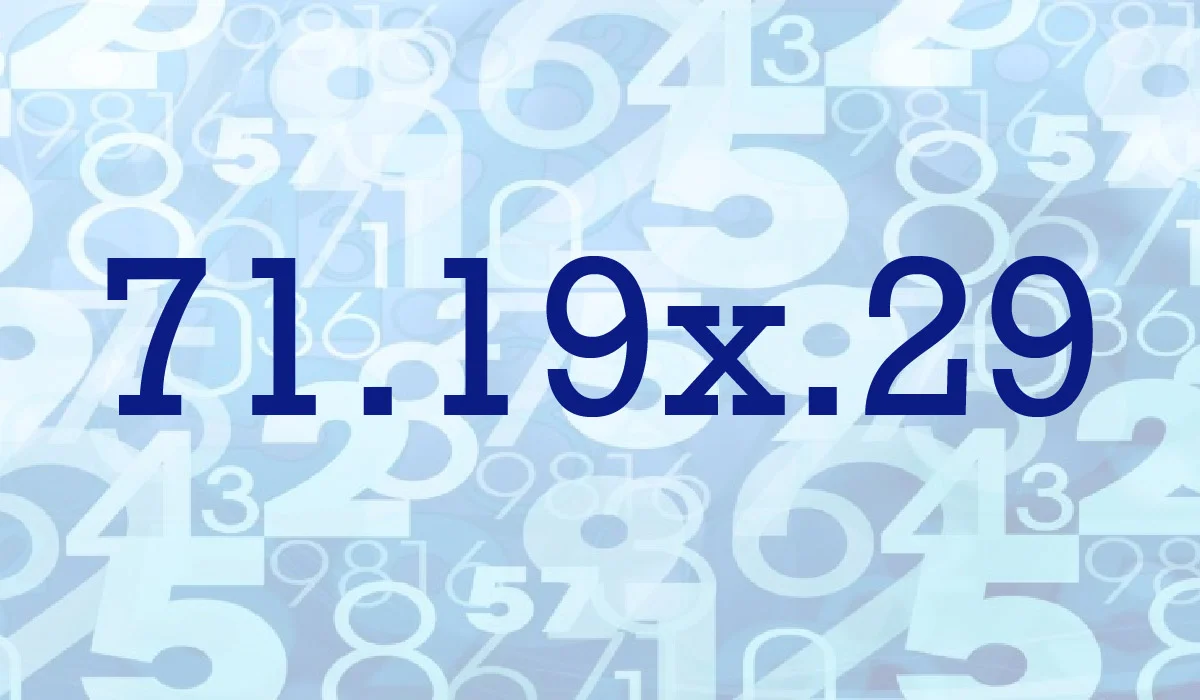71.19x.29: What You Need to Know About This Mysterious IP Address
If you’ve stumbled across 71.19x.29 and wondered what it means, you’re not alone. Whether it appeared in your network logs, firewall settings, or simply caught your attention on a forum, IP addresses with unusual formatting often raise questions.
In this article, we’ll break down what 71.19x.29 could represent, whether it’s a valid IP address, and what actions—if any—you should take. If you’re not tech-savvy, don’t worry; this guide explains everything in plain language.
What Is 71.19x.29?
At first glance, 71.19x.29 looks like an IP address, but there’s a catch. The format isn’t standard. A typical IPv4 address follows the pattern ###.###.###.###, using numbers from 0 to 255. So while parts like “71” and “19” make sense, the “x” throws things off.
This suggests that 71.19x.29 is either:
-
A placeholder for a variable IP (such as
71.19.*.29) -
A masked IP to hide or partially anonymize a real address
-
A typo or misleading entry in code, logs, or search engine results
Is 71.19x.29 a Real IP Address?
The short answer: No, not exactly.
Technically, 71.19x.29 is not a valid IPv4 address because IP addresses cannot contain letters like “x.” However, it might represent a pattern where:
-
“x” stands for any number between 0 and 255
-
The address is being intentionally obscured for privacy or cybersecurity reasons
-
It’s used as a placeholder in documentation or tutorials
So, while 71.19x.29 itself won’t resolve to an actual device or domain, a full version like 71.19.84.29 or 71.19.113.29 could be a legitimate IP.
Why Would You See 71.19x.29?
If this string appeared somewhere in your browsing or digital records, it could be for several reasons:
1. Security Tools or Firewalls
IT professionals and sysadmins often use wildcard formats in firewall rules, like 71.19.*.29, to block or monitor a range of IP addresses. The “x” could be a custom symbol representing any value in that octet.
2. Tutorials or Articles
Tech writers use anonymized or example IPs to avoid pointing to real addresses. So, 71.19x.29 might have been used in a blog post or instructional guide to illustrate a concept.
3. Network Scanning Tools
If you’re running a network monitoring tool, you might see outputs with partial or masked IPs. It’s a way of obfuscating full addresses in public-facing reports.
4. Suspicious Activity or Logs
Sometimes, suspicious logs include strange IP formats. If you see 71.19x.29 in connection with failed login attempts, bot activity, or unknown devices, it could be referencing a group of IPs from a particular provider or geographic region.
How to Investigate IPs Like 71.19x.29
If you want to trace down what this might mean in your specific case, here’s how:
● Replace “x” With a Wildcard
Use a tool like IPVoid or Whois Lookup and enter potential matches like 71.19.0.29 through 71.19.255.29 to check what pops up.
● Scan for Threats
Run a malware or network scan to ensure no unwanted connections are being made to or from IPs within the 71.19.x.29 range.
● Check Reverse DNS
Reverse DNS lookup tools can sometimes identify the domain name behind a specific IP. Try running a few possible variations.
● Consult Your Firewall Logs
If you’re a website admin or IT pro, dive into your logs. See what kind of traffic is originating from the 71.19 range and whether it aligns with normal behavior.
Frequently Asked Questions (FAQ) About 71.19x.29
Is 71.19x.29 dangerous?
Not inherently. It’s likely a placeholder or masked address. However, if you suspect unauthorized access or strange network activity, scan for threats.
Why do IP addresses get masked like this?
For privacy and security. Masking hides specific device locations, especially in public-facing documents or forums.
Can I block all addresses in the 71.19. range?*
Yes, but do so carefully. Blocking entire ranges may interrupt legitimate traffic, depending on the source and your network configuration.
Is 71.19x.29 from a specific country?
You’d need to test full IP variants (like 71.19.103.29) to determine the geographic origin. The base range (71.19..) often maps to ISPs in North America.
What should I do if I see this in my logs?
Investigate further. Use it as a starting point to review connection sources, validate user behavior, and update firewall rules if needed.
Final Thoughts on 71.19x.29
While 71.19x.29 might look cryptic at first glance, it’s usually nothing to panic about. It’s not a standard IP, but more likely a placeholder, masked value, or a generalized IP pattern.
That said, don’t ignore unusual IP behavior—especially if it’s tied to unknown logins or data requests. In cybersecurity, even small oddities deserve a closer look.
The internet is a complex place, but understanding little details like this makes you a more informed, safer user. And when in doubt, monitor, research, and, if necessary, block.
